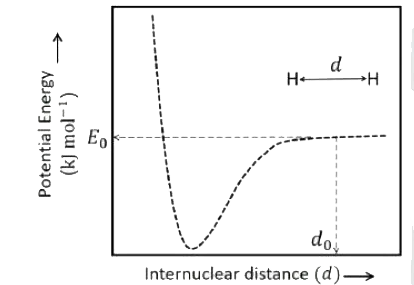The figure is the plot potential energy versus internuclear distance (d) of molecule in the electronic ground state. What is the value of the net potential energy (as indicated in the figure) in kJ , for at which the electron repulsion and the nucleus - nucleus repulsion energies are absent ? As reference , the potential energy of H atom is taken as zero when its electron and the nucleus are infinitely far apart.
use Avogadro as .

Video Solution
Text Solution
The correct Answer is:5246.5
For one H atom
Total potential energy for 2 - H - atom (per mole)
KJ/mole
|
Topper's Solved these Questions
- JEE ADVANCED 2020Book:JEE ADVANCED PREVIOUS YEARChapter:JEE ADVANCED 2020Exercise:SECTION-2
Explore 6 Videos
- JEE ADVANCEDBook:JEE ADVANCED PREVIOUS YEARChapter:JEE ADVANCEDExercise:CHEMISTRY SECTION - IV : Matric Match Type
Explore 2 Videos
- JEE ADVANCED 2021Book:JEE ADVANCED PREVIOUS YEARChapter:JEE ADVANCED 2021Exercise:QUESTION
Explore 38 Videos
Similar Questions
Knowledge Check
If the potential energy is taken zero at ground state of hydrogen atom in place of infinity then
ATotal energy of atom will get changedBBinding energy of hydrogen atom in ground state will remain unchangedCKinetic energy of electron in ground state will get changedDEnergy of photon generated because of de-excitation of atom from first excited state will remain unchangedAs electron moves away from the nucleus, its potential energy
AIncreasesBDecreasesCRemains constantDNone of theseLet the potential energy of the hydrogen atom in the ground state be zero . Then its energy in the excited state will be
A10.2eVB13.6eVC23.8eVD27.2eV
As electron moves away from the nucleus, its potential energy
View SolutionIf the ionisation potential of a H-atom is ω, then its energy in the first excited state is
View SolutionThe ratio of the kinetic energy and the potential energy of electron in the hydrogen atom will be
View SolutionIf the potential energy of a H-atom in the ground state be zero then its potential energy in the first excited state will be
View SolutionAn electron in H atom jumps from the third energy level to the first energy .The charge in the potential energy of the electron is
View Solution

